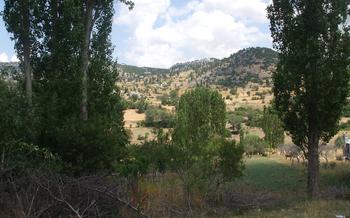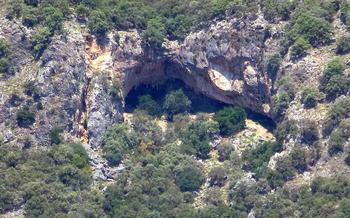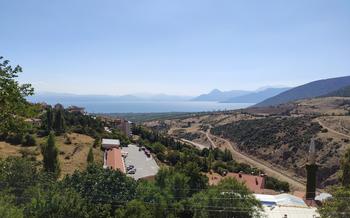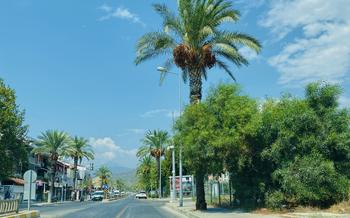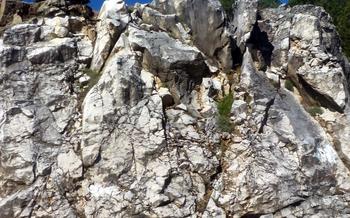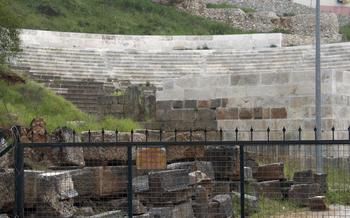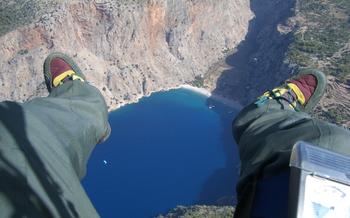
Tlos Ancient City
- Exploring the Acropolis: The Heart of Ancient Tlos
- The Theater of Tlos: A Stage for History
- The Agora and Commercial Areas
- The Necropolis and Tombs
- The Stadium and Sports Facilities
- The City Walls and Gates
- The Roman Baths and Aqueduct
- The Byzantine Church: A Testament to a Changing Era
- Local Cuisine and Dining Options
- Accommodation and Where to Stay
- Nearby Attractions and Side Trips
- Insider Tip:
Exploring the Acropolis: The Heart of Ancient Tlos
The acropolis of Tlos, perched atop a hill overlooking the fertile plain, served as the heart of the ancient city. Its strategic location provided both defensive advantages and sweeping views of the surrounding landscape, making it an ideal place for the city's rulers to reside. Within the acropolis, visitors can explore a treasure trove of well-preserved structures that offer a glimpse into the city's glorious past.
The most prominent feature of the acropolis is the theater, a marvel of ancient engineering that could accommodate up to 4,000 spectators. Its remarkably intact stage and seating tiers create an evocative setting, allowing visitors to imagine the lively performances and civic gatherings that once took place here. The theater's exceptional acoustics ensure that even whispers can be heard from the back rows, creating an immersive experience for performers and audience members alike.
Other notable structures within the acropolis include temples dedicated to various deities, administrative buildings, and residential quarters. These ruins provide valuable insights into the daily lives of the Tlosians, their religious beliefs, and their political system. The acropolis also offers breathtaking panoramic views of the surrounding countryside, with the Taurus Mountains forming a majestic backdrop to the ancient ruins.
To fully capture the grandeur of the acropolis, be sure to bring your camera and a wide-angle lens. The best time to visit is early morning or late afternoon, when the golden light casts dramatic shadows across the ruins, creating stunning photo opportunities. Whether you're a history buff, an architecture enthusiast, or simply someone who appreciates the beauty of ancient ruins, the acropolis of Tlos is a must-visit destination that will leave you in awe.
The Theater of Tlos: A Stage for History
Amidst the ruins of Tlos, the theater stands as a testament to the city's cultural and artistic heritage. Carved into the hillside, this magnificent structure could accommodate thousands of spectators, who gathered to witness theatrical performances, musical concerts, and public assemblies.
With its exceptional acoustics, the theater provided an immersive experience for audiences, allowing them to hear every word and every note with remarkable clarity. Even today, visitors can stand on the stage and marvel at the perfect sound quality, transporting them back to a time when the theater was filled with the voices of actors, musicians, and cheering crowds.
The theater of Tlos is not just an architectural marvel but also a symbol of the city's vibrant cultural life. It hosted a variety of performances, from comedies and tragedies to musical recitals and dance shows. These events brought people together, fostering a sense of community and shared experiences.
Over the centuries, the theater has undergone several restorations, with ongoing efforts to preserve its grandeur for future generations. The challenges of preserving such a vast and ancient structure are immense, but the rewards are equally significant.
As you explore the theater of Tlos, let your imagination take flight. Picture the stage adorned with colorful costumes and props, the actors delivering powerful monologues, and the audience erupting in laughter or applause. The theater may be silent now, but its history reverberates through the ages, waiting to be discovered by every visitor who steps onto its stage.
The Agora and Commercial Areas
The agora, or marketplace, was the bustling heart of Tlos, where economic activities thrived and social interactions flourished. As you explore the ancient city, you'll encounter remnants of shops, workshops, and public buildings that once lined this vibrant thoroughfare.
Imagine merchants displaying their wares, artisans crafting intricate goods, and the lively chatter of buyers and sellers filling the air. The agora was not just a place of commerce but also a social hub, where people gathered to exchange news, engage in debates, and conduct civic affairs.
Excavations have revealed a wealth of artifacts and inscriptions that shed light on the economic activities and trade routes that connected Tlos to the wider region. Discover coins, pottery fragments, and inscriptions recording transactions, offering glimpses into the daily lives of the Tlosians and their interactions with neighboring cities.
As you wander through the agora, let your imagination transport you back in time to witness the hustle and bustle of this vibrant marketplace, where the ancient world came alive with the sounds of commerce and the spirit of community.
The Necropolis and Tombs
The necropolis of Tlos, located outside the city walls, is a fascinating testament to the funerary practices and beliefs of the ancient Tlosians. Elaborate rock-cut tombs and sarcophagi line the hillside, each adorned with intricate carvings and inscriptions that provide glimpses into the lives and legacies of the deceased. The most notable among these is the Tomb of Bellerophon, a legendary hero in Greek mythology. The tomb features a stunning relief depicting Bellerophon slaying the Chimera, a mythical creature with the head of a lion, the body of a goat, and the tail of a serpent. The artistry and craftsmanship of the tomb are remarkable, making it a must-see for visitors interested in ancient mythology and funerary customs.
The Stadium and Sports Facilities
The ancient city of Tlos also boasts an impressive stadium, a testament to the importance of physical fitness and athletic competitions in ancient Lycian society. Located outside the city walls, the stadium is a remarkable example of engineering and design, with its elongated shape and terraced seating that could accommodate thousands of spectators.
The dimensions of the stadium are impressive, with a length of approximately 200 meters and a width of 50 meters. The seating arrangements were carefully designed to provide optimal views of the events taking place in the arena below. The tiers of seats were divided into sections, with the lower rows reserved for officials and dignitaries, while the upper rows were accessible to the general public.
Evidence suggests that the stadium was used for a variety of sporting events, including footraces, wrestling, and chariot races. The Lycians were known for their athletic prowess, and these competitions were a way for them to showcase their skills and strength. The stadium also served as a venue for other public events, such as religious festivals and theatrical performances.
Imagine the roar of the crowd as chariots thundered around the track, or the cheers of the spectators as athletes competed for victory in footraces. The stadium was a place of excitement and entertainment, where the community came together to celebrate the spirit of sportsmanship and athleticism.
The City Walls and Gates
The ancient city of Tlos was surrounded by impressive city walls, which served as a crucial defensive mechanism against potential invasions. These walls were constructed using large blocks of stone, showcasing the advanced engineering skills of the Tlosians. The walls featured several gates, including the East Gate, which allowed entry and exit to the city. The gates were strategically positioned and heavily fortified, often consisting of multiple layers of defense. The city walls not only protected Tlos from external threats but also played a vital role in maintaining order and security within the city.
The Roman Baths and Aqueduct
The ancient city of Tlos also boasts impressive Roman baths, a testament to the advanced engineering and luxurious lifestyle of its inhabitants. These well-preserved baths feature a caldarium, a room designed for hot baths, with intricate mosaics adorning its floor. The remains of the aqueduct system, which once supplied water to the city, stand as a testament to the Romans' mastery of water management. Explore these ruins to gain insights into the daily lives and bathing culture of the ancient Tlosians, who valued cleanliness and relaxation.
The Byzantine Church: A Testament to a Changing Era
Amidst the ruins of Tlos, the Byzantine Church stands as a testament to the city's transition from paganism to Christianity. Its architectural features, though weathered by time, hint at the grandeur and devotion that once filled its walls. The apse, once adorned with intricate mosaics, now reveals fragments of biblical scenes and stories. The nave, with its rows of columns, speaks of a time when the faithful gathered to worship and seek solace within these sacred walls.
Although much of the church lies in ruins, its presence evokes a sense of reverence and awe. One can almost imagine the echoes of hymns and prayers that once resonated through its chambers. The Byzantine Church, with its silent yet eloquent presence, reminds visitors of the rich religious history that has shaped Tlos and the surrounding region.
Local Cuisine and Dining Options
Tantalize your taste buds with the delectable flavors of traditional Turkish cuisine in the local restaurants near the ancient city of Tlos. Immerse yourself in a culinary journey that blends the region's rich history with the freshest ingredients. Savor the aromatic kebabs, succulent grilled meats, and freshly caught seafood, all infused with unique spices and herbs. Don't miss the opportunity to try gözleme, a traditional Turkish flatbread stuffed with savory fillings like cheese, spinach, or minced meat.
For a truly authentic dining experience, venture into the charming local restaurants that line the cobblestone streets. Let the warm hospitality of the locals welcome you as you indulge in their culinary creations. Discover hidden gems where you can relish traditional Turkish dishes prepared with love and passed down through generations.
Vegetarians and those with dietary restrictions can rejoice, as Tlos offers a diverse range of dishes that cater to your needs. Explore the vibrant array of fresh salads, meze platters, and vegetable-based dishes that showcase the region's culinary versatility. Rest assured, you won't miss out on the tantalizing flavors that define Turkish cuisine.
Accommodation and Where to Stay
When planning your trip to Tlos, a range of accommodation options awaits you near the ancient city. From cozy guesthouses to traditional Turkish houses and modern hotels, there's something to suit every taste and budget. For a truly authentic experience, immerse yourself in the local culture by opting for a traditional Turkish house. These charming accommodations offer a glimpse into the region's heritage and provide a unique opportunity to connect with the local way of life.
To secure the best deals and avoid any last-minute surprises, booking your accommodation in advance is highly recommended. Take advantage of online booking platforms to compare prices, read reviews, and choose the option that best fits your needs.
If you're seeking insider tips, consider venturing beyond the immediate vicinity of the ancient city. Nearby towns and villages offer hidden gems in the form of charming guesthouses and boutique hotels. These accommodations often provide a more intimate and personalized experience, allowing you to fully embrace the region's hospitality.
No matter your choice, make sure to do your research and read reviews from fellow travelers to ensure a comfortable and memorable stay.
Nearby Attractions and Side Trips
Apart from the awe-inspiring Tlos Ancient City, the region boasts a plethora of other captivating attractions and natural wonders that beckon you to explore. Embark on a day trip to the picturesque town of Fethiye, where you can delve into the depths of history at the Fethiye Museum, housing an array of artifacts from the region. Marvel at the intricate Lycian rock tombs carved into the cliffs, silent witnesses to the past.
Venture further to the stunning Butterfly Valley, a haven of tranquility where vibrant butterflies flutter amidst a kaleidoscope of wildflowers. Immerse yourself in the tranquility of the valley, far from the madding crowd, and let nature's symphony soothe your soul.
For those seeking an adrenaline rush, paragliding from Babadağ Mountain offers an exhilarating experience with breathtaking views of the turquoise waters and verdant landscapes below. Soar like an eagle and feel the wind in your hair as you glide over this magical region.
Insider Tip:
Make sure to visit the local market in Fethiye, a treasure trove of fresh produce, handmade crafts, and local delicacies. Engage with the friendly vendors, savor the vibrant atmosphere, and perhaps even uncover some hidden culinary gems to tantalize your taste buds.
